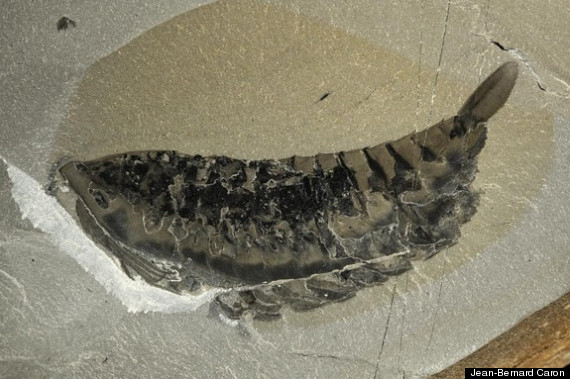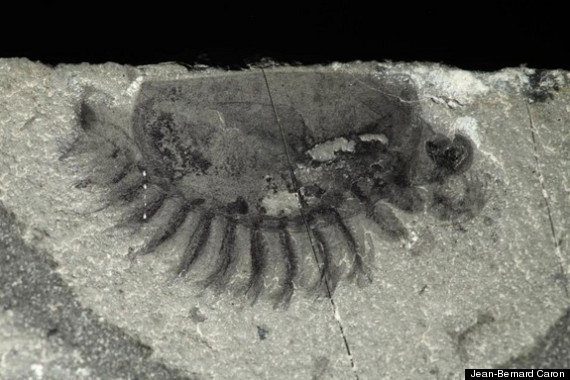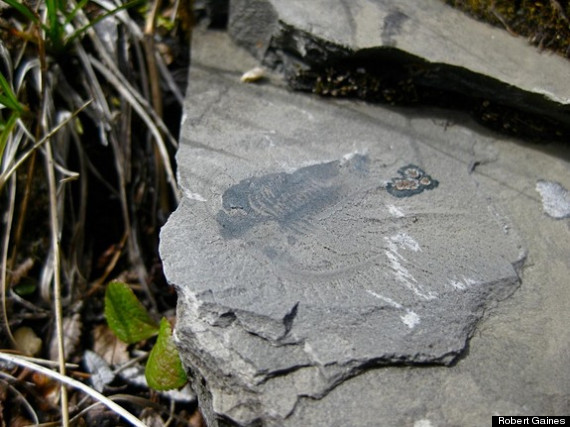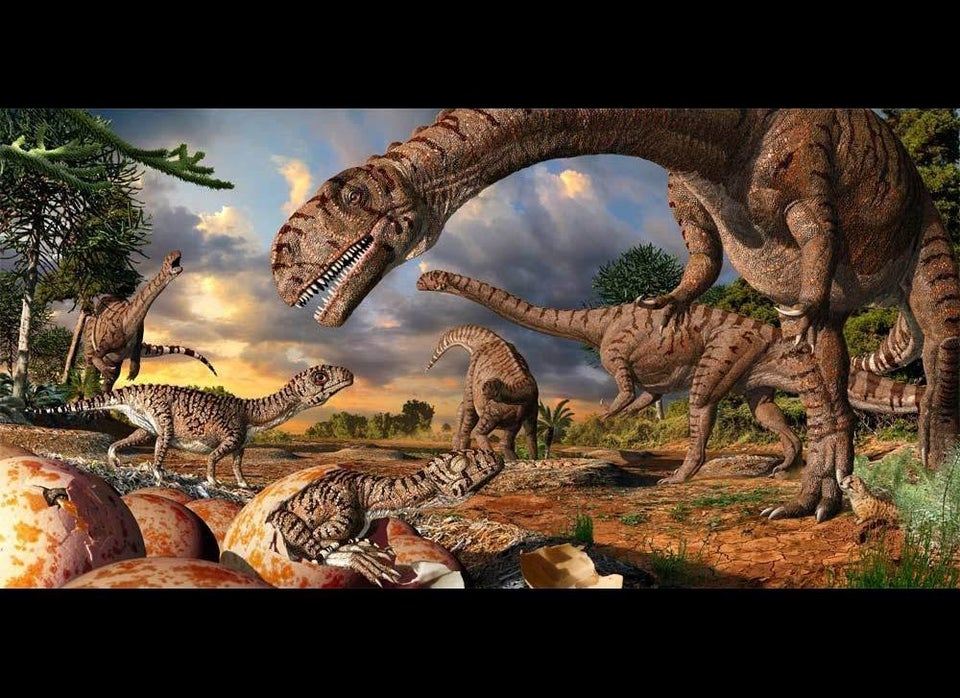
A treasure trove of fossils chiseled out of a canyon in Canada's Kootenay National Park rivals the famous Burgess Shale, the best record of early life on Earth, scientists say.
"Once we started to break fresh rock, we realized we had discovered something incredibly special," said Robert Gaines, a geologist at Pomona College in Pomona, Calif., and co-author of a new study announcing the find. "It was an extraordinary moment."

Canyon fossil site is southeast of the original Burgess Shale fossil quarry, discovered in 1909.
The Burgess Shale refers to both a fossil find and a 505-million-year-old rock formation made of mud and clay. The renowned Burgess Shale fossil quarry, a UNESCO World Heritage site located in Yoho National Park, is in a glacier-carved cliff in the Canadian Rockies. The fossils were discovered in 1909. Since then, several other fossil sites have been found in the Burgess Shale, but none as rich as the original.
The fossils are extraordinary because they preserve soft parts of ancient animals in exceptional detail; these soft parts are less likely to be imprinted in stone than harder parts, like bones. More than 200 animal species have been identified at the 1909 fossil site, providing a rare window into the Cambrian explosion, the time when complex body forms first appeared in Earth's fossil record starting about 542 million years ago.

A cleaned and preserved Leanchoilid fossil reveals the animal's delicate appendages.
"Nowhere do we have a better view of exactly what the Cambrian looked like and its relationship to the environment than in the Burgess Shale," Gaines told Live Science's Our Amazing Planet.
The new site is also in the Burgess Shale formation, and seems to rival the 1909 original in fossil diversity and preservation, researchers report today (Feb. 11) in the journal Nature Communications. In just two weeks, the research team collected more than 3,000 fossils representing 55 species. Fifteen of these species are new to science. [Gallery: Amazing Cambrian Fossils from Canada's Marble Canyon]
"The rate at which we are finding animals — many of which are new — is astonishing, and there is a high possibility that we'll eventually find more species here than at the original Yoho National Park site, and potentially more than from anywhere else in the world," said Jean-Bernard Caron, lead study author and an invertebrate paleontologist at the Royal Ontario Museum in Toronto.
Better than Burgess
The new fossils were spotted in a mountain cliff, in Marble Canyon, about 26 miles (42 kilometers) southeast of the original Burgess Shale site. Researchers hope to protect the exact location to prevent looting. (Visitors to the Burgess Shale quarry must hike with a park guide and leave their backpacks behind when they approach the fossils.)
The newly discovered rocks are probably about 100,000 years younger than those at the first Burgess Shale site, based on comparisons to similar fossils found elsewhere, Gaines said.
Many of the fossils at the new site are better preserved than their quarry counterparts, the researchers report. The new fossils reveal the internal organs of several different arthropods, the most common type of animal in both the new and old Burgess Shale locations. Retinas, corneas, neural tissue, guts and even a possible heart and liver were found.
"This is the first time we're seeing these details," Gaines said.

A new arthropod species discovered at the Marble Canyon outcrop.
Arthropods, the most diverse animal group on Earth, are the ancestors of many living creatures, including spiders, shrimps and insects. During the Cambrian period, they slashed their way through the sea, using pincers and clawlike appendages to tear apart their prey before shoving it into their mouths. Other arthropods developed hard parts, such as shells, to protect themselves from their fellow predators. This "arms race" between predator and prey is one of the drivers of the Cambrian explosion, scientists think.
About half of the 55 species discovered at Marble Canyon so far are also found at the original Burgess Shale site, the researchers report. Some of the original site's rare species are more abundant in the canyon, such as the polychaete worm Burgessochaeta. But "sessile" species are scarce or missing. These creatures, such as sponges and brachiopods, spend their lives attached to the rocks or the seafloor.

A Marella splendens fossil.
Some species at Marble Canyon are also found in China's Chengjiang fossil beds, which are 10 million years older than the Burgess Shale. Until now, researchers thought these Cambrian animals went extinct by the time the Burgess Shale formed. Their discovery in Canada means that many Cambrian life forms were more widespread and longer-lived than previously thought, the researchers said. [Image Gallery: Fantastic Fossils]
Fossil trackers
Gaines and his colleagues discovered the Marble Canyon fossils in 2012 as they were tracing Cambrian rocks on foot across the Rockies, in hopes of finding more Burgess Shale-type deposits. They had started a couple of miles away, at a fossil site in shallow-water rocks near Stanley Glacier. Near Marble Canyon, the team suddenly crossed over an ancient cliff. Known as the Cathedral Escarpment, this cliff marked the underwater edge of Laurentia, the ancestral continent that forms the core of North America.
"We encountered a major change in the rock type, just like at the classic Burgess Shale locality," Gaines said. "We would have gone over a cliff if we were in Cambrian time, but all this was happening horizontally on a mountainside. We had a hunch that if we followed the formation along the mountain topography into new areas with the right rock types, maybe, just maybe, we would get lucky, though we never in our wildest dreams thought we'd track down a mother lode like this."
The rocks hosting the Marble Canyon fossils are within the Burgess Shale, but are of a slightly different composition, or lithology, the researchers report. "The lithology in which the fossils occur is interestingly different from the Burgess Shale. This hints at different paleoenvironmental and taphonomic conditions and so widens our appreciation of the animals that populated the Cambrian explosion," said Simon Conway Morris, a Burgess Shale expert at Cambridge University in the U.K., who was not involved in the study.
Scientists think the soft-bodied fossils preserved in the Burgess Shale were swept down the Cathedral Escarpment by swift storm currents and were buried in deepwater muds. The animals likely lived below the reach of storm waves but above the depths of their final resting place.
"I think the most profound implication is that the Burgess Shale can't just be the only one that there is," Gaines said. "There's a lot more out there in the Canadian Rockies and other places."
Email Becky Oskin or follow her @beckyoskin. Follow us @OAPlanet, Facebook and Google+. Original article at Live Science's Our Amazing Planet.
